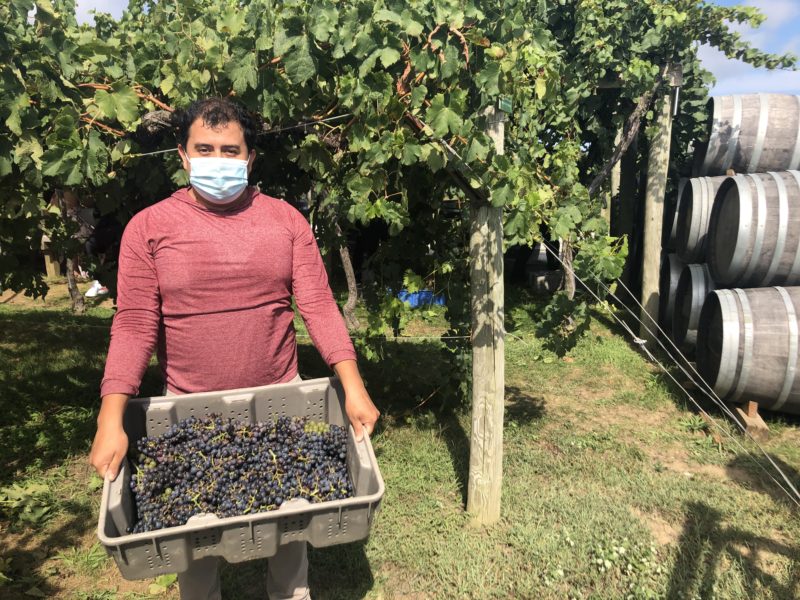

“Someday, we may not even have the wines that we now know, like Chardonnay and Burgundy,” says Larry Perrine, partner at Channing Daughters Winery in Bridgehampton.
“But we’ll always have rosé, right?” I ask, trying to hide the tears in my eyes.
He goes on to explain that while the viniculture experts are busy grafting new, more esoteric varietals that are more resilient to climate change, vineyards still face enormous challenges. Grapes don’t deal well with extremes. Less rain means grapes can ripen too early. Too much rain could lead to more pests, fungi and mildew. Stronger hurricanes can wipe out an entire vineyard. Says Alice Wise, viticulture research specialist at Cornell University, “When there’s pelting rain in the fall, heavy, ripe grapes can snap a vine, and rain could puncture the grape skin or split it.”
Since almost 70 percent of the wine industry’s carbon footprint comes from transporting heavy bottles, the best thing we can do for the planet is drink local.
East End wines aren’t exactly top of mind when popping into the liquor store. Most people have a go-to Italian or French brand. Some have an almost Pavlovian response to the word Sonoma on a label. Yet today, with over 60 wineries on the North and South forks alone, even the most persnickety wine snob can find a wine they like.
In a 1976 blind taste test known as The Judgement of Paris, California wines won out over French, which peeved a few Frenchmen, and changed the industry forever. At the slightly lesser known Judgment of Riverhead at Roanoke Vineyards in 2010, East End wines held their own against California vintages, and judges had a hard time telling the difference between French and North Fork wines. Vive la similarity!
Richard Pisacano, vineyard manager of Wölffer Estate Vineyard in Sagaponack, explains the popularity.
“Our wines, with their proximity to the ocean, are a sort of happy medium between the freshness of northern latitudes and the richness of the Mediterranean.”
From a culinary point of view, pairing local wine with local food just makes sense. As the adage goes, ‘What grows together goes together.’ In Oregon, Pinot Noir pairs with local salmon. In northern Spain, a lamb stew pairs with Rioja. Mike Falcetta, of Sparkling Pointe Vineyards in Southold notes, “Everyone wants local tomatoes and corn. Wine would follow suit. Crisp local wine pairs perfectly with local seafood.”
One can also pair wine with the place itself. After a long day at the beach, you’re hot and sandy, post-beach vibe pairs perfectly with the light, fruity rosés that the East End has become known for.
If you do go farther afield, heavy bottles shipped on barges from Europe actually emit fewer greenhouse gases than West Coast wines that are sent by truck or plane. Crates shipped by sea have a carbon footprint 11 times lower than when flown in.
Consider alternatives that are easier to recycle and don’t weigh as much in shipping. Wine in a box may connote a certain trailer park ambiance that pairs nicely with a large bag of Cheetos, but they are stepping up their game. Remember when screw caps were unheard of? The more environmental wine in a can is also becoming all the rage amongst young beach goers.
If throwing a party (remember those?), consider keg wine. No longer the purview of college frat boys, now you can find some very drinkable choices. At 120 glasses per keg (roughly 26 bottles), it’s considerably cheaper than buying by the bottle.
The easiest way to figure out which local wineries are environmental is to look for the Long Island Sustainable Winegrowing (LISW) Certificate seal. Members of LISW must adhere to nearly 200 sustainable grape growing practices that reduce the use of chemicals and fertilizers.
Replacing conventional fertilizer with organic compost helps keep nitrogen from running into our bays, creeks and groundwater. While most organic compost can come from the orchard itself, some wineries get creative. Channing Daughters gets manure from a neighbor’s horse farm. Raphael Winery uses it from a nearby duck farm.
Spraying fewer fungicides, pesticides and herbicides is also a game changer.
“It’s like using preventative medicine instead of applying a bunch of chemicals after the vines get sick,” says Steve Carlson of Bedell Cellars in Cutchogue. Using a practice the French aptly call triage, smaller vineyards hand pick the healthy grapes, rather than using machinery. Says Suellen Tuney, at McCall Wines, also in Cutchogue, “If you hand harvest, you can inspect the grapes for insects and fungus, so you don’t need to spray fungicides and insect repellent.”
There are a few simple ways to spot a climate-friendly winery even before setting foot in the tasting room. What at first looks like a negligent, disorderly vineyard, is really the opposite. Grape vines shouldn’t grow all the way up to the back door. Instead, look for a diversity of native plants that host all kinds of insects and birds. In between rows, weeds and wild flowers protect the soil from erosion.
“If the winery looks like a golf course, it’s probably un-environmental,” says Anthony Nappa of Raphael Winery in Peconic. “Perfectly manicured grounds are an indication that they’re overdoing it. It’s a farm!”
Chelsea Frankel, of Shinn Estate Winery in Mattituck, describes grapes as more anthropomorphic. “Grapes are like teenagers. You help a little bit where needed, but let them be independent.”
When tasting rooms do open back up, notice the little things. Does the winery use a new glass for each pour? Wölffer Estate offers biodegradable bamboo plates and cutlery, and recycles barrels into planters. Sparkling Pointe Winery cools its zero energy warehouse with solar. Shinn Estate Vineyard is one of the only wineries in the United States that makes wine with just four ingredients and that lists them right on the label.
Sustainably grown wine is the gold standard out here, but organic is comparable when it comes to protecting the environment. They both just use different criteria in terms of regulation. Natural wine, the newest ancient trend, is a sort of untamed wine with nothing added to it. Because of the uncontrolled fermentation process, it can taste a little bit funky. Biodynamic practices follow a form of rigorous, yet controversial environmentalism, taking into account astrological influences such as planting on ‘root days’ and harvesting on ‘fruit days.’
And don’t forget, if you’re really going to drink responsibly, never let a single drop go to waste! Thanks for reading, planet fans. Cheers!
 More Posts from Jenny Noble
More Posts from Jenny Noble